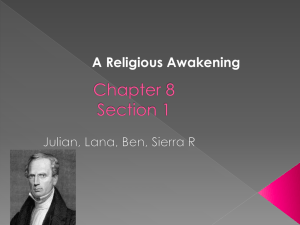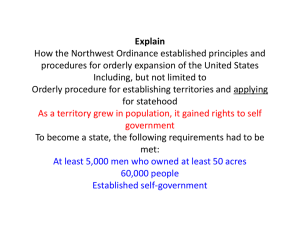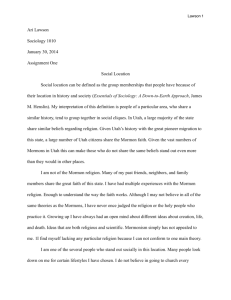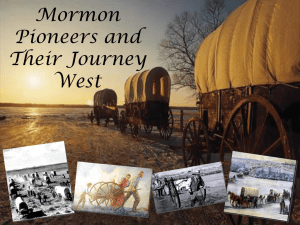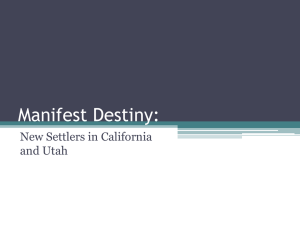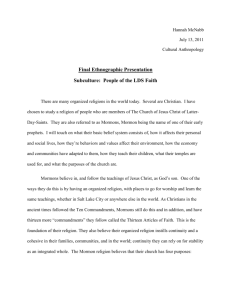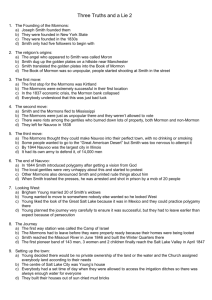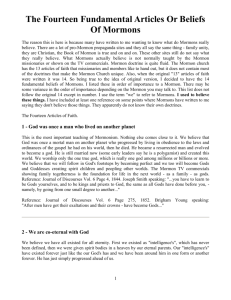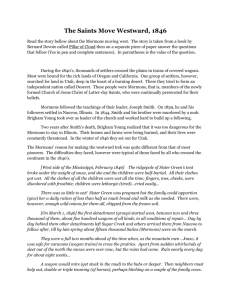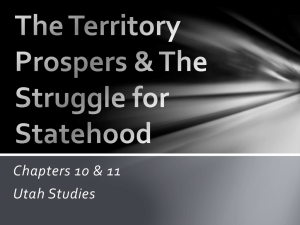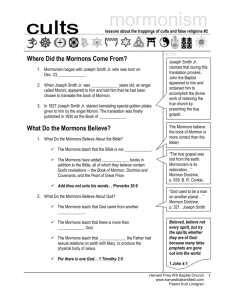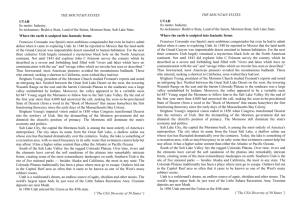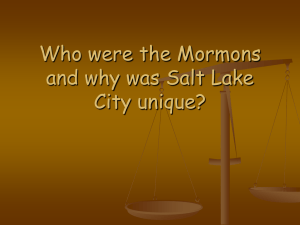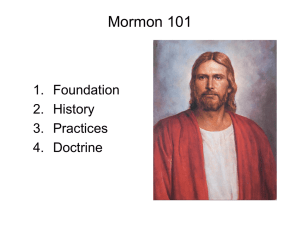Religious Refuge in Utah
advertisement
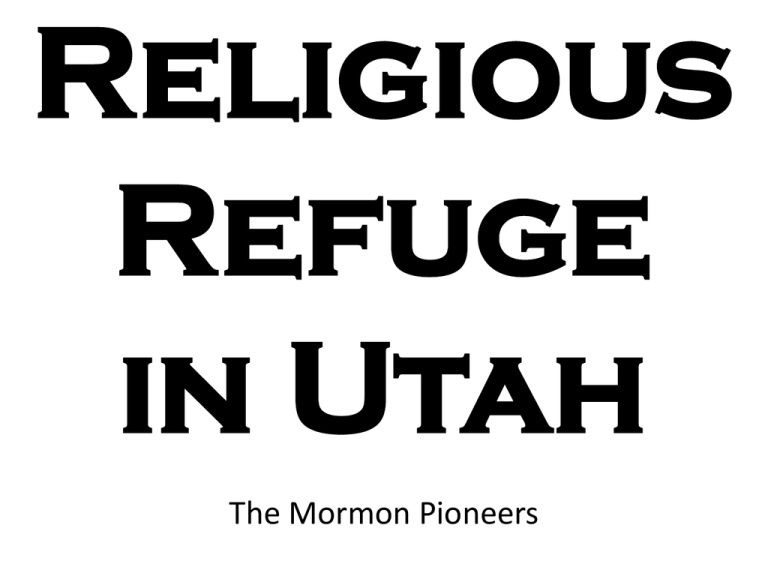
Religious Refuge in Utah The Mormon Pioneers Mormon Pioneers • Church was founded in 1830 by Joseph Smith in New York State • Formed a community in New York, but unsympathetic neighbors disapproved of the Mormons’ religion • Mormons were forced to move on – New York to Ohio, then to Missouri, and then Illinois Persecution Once Again • 1844 a mob in Illinois killed Smith • Brigham Young took charge of the Mormons • Young decided to move the Mormons again • Pushed on near the Great Salt Lake in Utah – At this time, Utah was still part of Mexico – However, the Mormons didn’t face trouble because no Mexicans had settled the region • Harsh terrain A Haven in the Desert • 1846: Mormon Migration to the GSL began • 12,000 made up the trek – Largest single migration in American History “This is the Place” • Set up communities in an area they called Deseret – Carefully planned towns – Built irrigation canals to water their farms – Founded industries • Sold supplies to the 49ers as they passed through to California Statehood • 1848: U.S. acquires the Salt Lake area • 1850: Congress establishes the Utah Territory • 1896: After many attempts for statehood, Utah becomes the 45th state – Applied for statehood 5 times • Government was weary of the Mormons – U.S. and Mormons almost went to war in 1857 and 1858 • State of Deseret got smaller and smaller each time North’s Economy Chapter 13 Sections 1-2 Technology and Industry • During the 1800s, advances in technology and transportation shaped the North’s economy – Before 1800: • Most people worked on farms • Most goods were made by hand, one at a time – Blacksmiths, tailors, shoemakers • Changes on how Americans worked, traveled, and communicated – Power-Driven Machinery – Industrialization – Technology North’s Ability to Industrialize • New Methods in Technology and Business – Increase production – Raise money to fund other things • Rich supply of natural resources • Three Factors of Production: 1. Land 2. Labor 3. Capital FACTORS OF PRODUCTION Land • All the land • All the natural Resources located on the land Labor • Number of workers - Need workers to turn raw materials into goods Capital • Equipment that’s used in production of goods – Buildings – Machinery – Tools • Money for investments – Large amounts of money were needed to finance industrial growth Production of Goods Land and Labor are needed to produce capital goods Capital Goods are needed to produce consumer goods People can buy manufactured goods Improved Transportation • Contributes to the success of America’s new industries • 1807: Robert Fulton’s Steamboat – Faster and more reliable than flatboats or sail-powered vessels • 1800-1850: Built thousands of miles of roads and canals – Open new shipping routes by connecting lakes and rivers – Growth of Cities – Connection of farms in the Midwest to cities in the Northeast • 1840-1850s: Growth of Railroads – Speed the flow of goods – 1869: Transcontinental Railroad is completed Faster Communication • Telegraph – Uses electric signals to transmit messages • Samuel Morse – Morse Code • May 24, 1844: First successful telegraph message • Series of dots and dashes representing letters of the alphabet North’s Agriculture • Railroad gave farmers access to new markets to sell their products • Advances in technology increased the size of harvest people could produce • 1800s: Farmers move to the Great Plains of Missouri, Iowa, Minnesota – Afraid to move farther west because of the matted sod and infertile soil ADVANCES TO AGRICULTURE • Inventions: – John Deere’s Steel-tipped plow in 1837 • Stronger to cut through hard packed sod – Cyprus McCormick’s Mechanical Reaper • Sped up the harvesting of wheat – Thresher • Separates the grain for the stalk • Slavery largely disappears in the North by 1830s – Still have prejudice, segregation, and discrimination • Couldn’t vote, attend public schools or facilities • Forced into separate schools and hospitals Telegraph, Steel Tipped Plow, Reaper, Thresher, Steamboat, Improvements: Communication, Production of Goods, Transportation, Agriculture Growth of cities: New Waterways, Railroads, More Extensive Area Reached By Railroads, Canals, Roads, Growth of Factories NORTH’S ECONOMY New Inventions: GROWTH OF THE U. S. ADVANCES IN TECHNOLOGY WHY IS THIS IMPORTANT? Cash Crops, Quicker and Cheaper Transfer of Goods, Growth of Markets, Money to Fund Industrial Growth Northern Factories • Although there were many advances in agriculture, the North was focused on INDUSTRY • 1820-1860: Growth of Mills and Factories – Before this time, small shops (Blacksmiths, Shoemakers, etc.) • Machines took over many production tasks – Clothing, Textiles, Shoes, Watches, Guns, Sewing Machines, Agricultural Machinery Factory System • Bad and Dangerous Working Conditions • Longer Hours Worked to Produce More Goods – 1840: Working days averaged 11.4 hours • Increase in On-The-Job Accidents – Loss of limbs, Death • Factory Owners Push for Profits – Don’t care about the security or safety of employees • Formation of Trade Unions – Strikes • Shorter Hours, More Pay, Better Working Conditions Immigration • 1840-1860: Dramatic Increase in immigration – Manufactures welcome immigrants • Desperate for work, even if it meant working long hours for little pay • Numbers: – – – – – 1820s: 10,000 1830s: 20,000 1840s: 80,000 1850s: 360,000 1860s: 155,000 • Percentages: - 1820-1840: Ireland 35% Germany 22% Great Britain 14% All Others 29% - 1841-1860: Ireland 33% Germany 32% Great Britain 16% All Others 13% Waves of Immigrants • 1846-1860: – More than 1.5 Million immigrants come from Ireland – Potato Famine killing more than 1 million (1840s) • Most were Farmers who didn’t have money to buy land – Took low-paying jobs in Northern factories • 1848-1860: – More than 1 Million come from Germany – Democratic Revolution (1848) • Most had money to settle and establish industry • Most went to the Midwest IMPACT OF IMMIGRATION • Change the character of the country – Bring their own languages, customs, religions, culture • Before 1800s: Mainly Protestants from Great Britain or slaves – Through Immigration, more and more Roman Catholics from Germany and Ireland • 1830-1840s: Anti-Immigrant Feelings – Nativists were against immigration • Create the American Political Party – Known as the Know-Nothing Party » Stricter Laws for Citizenship • Extending time to gain citizenship from 5 to 21 years » Ban Foreign-Born Citizens from holding office » Anti-Catholic Societies • What are 3 reasons why people might be against immigration? • Prejudice, Discrimination
